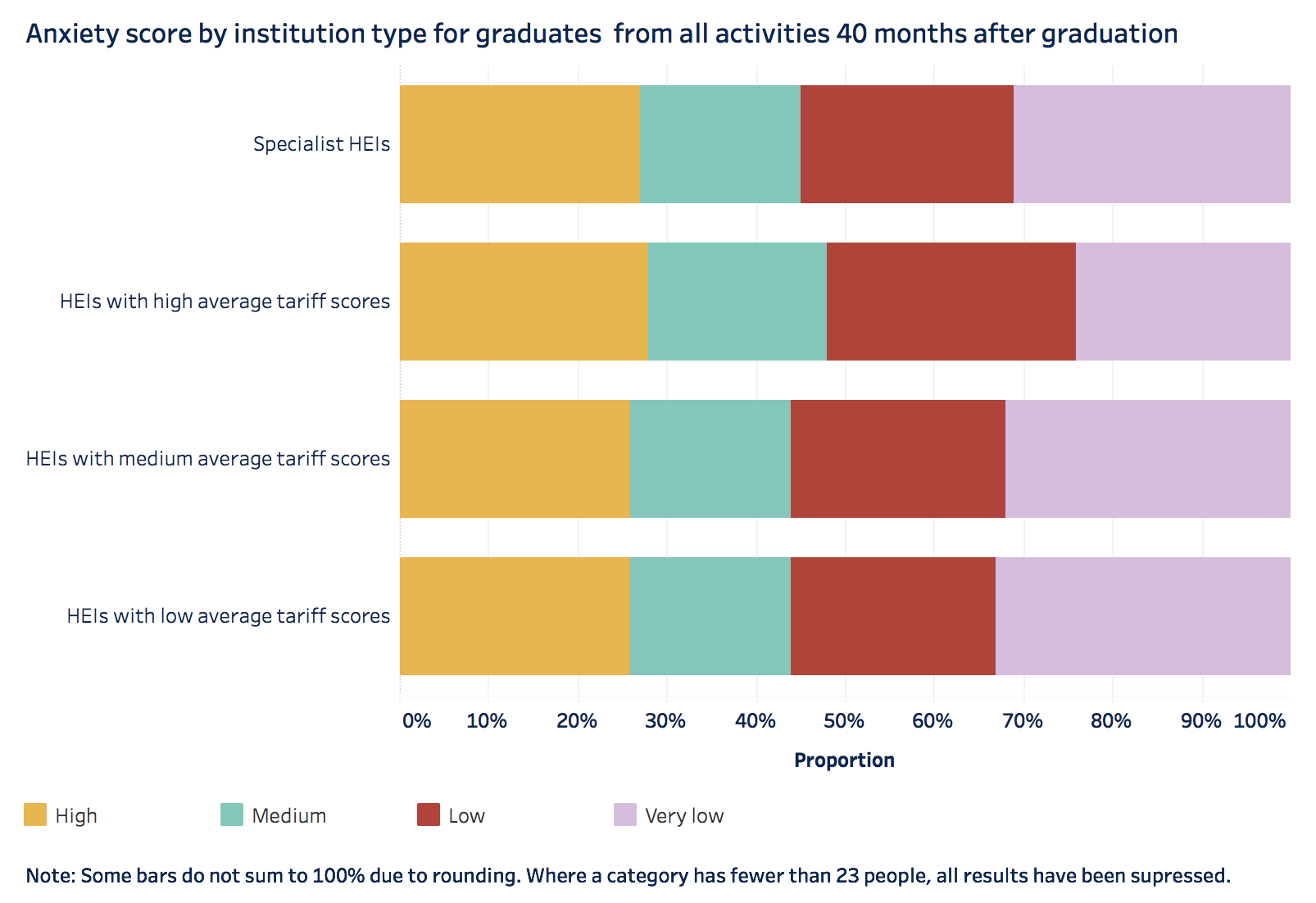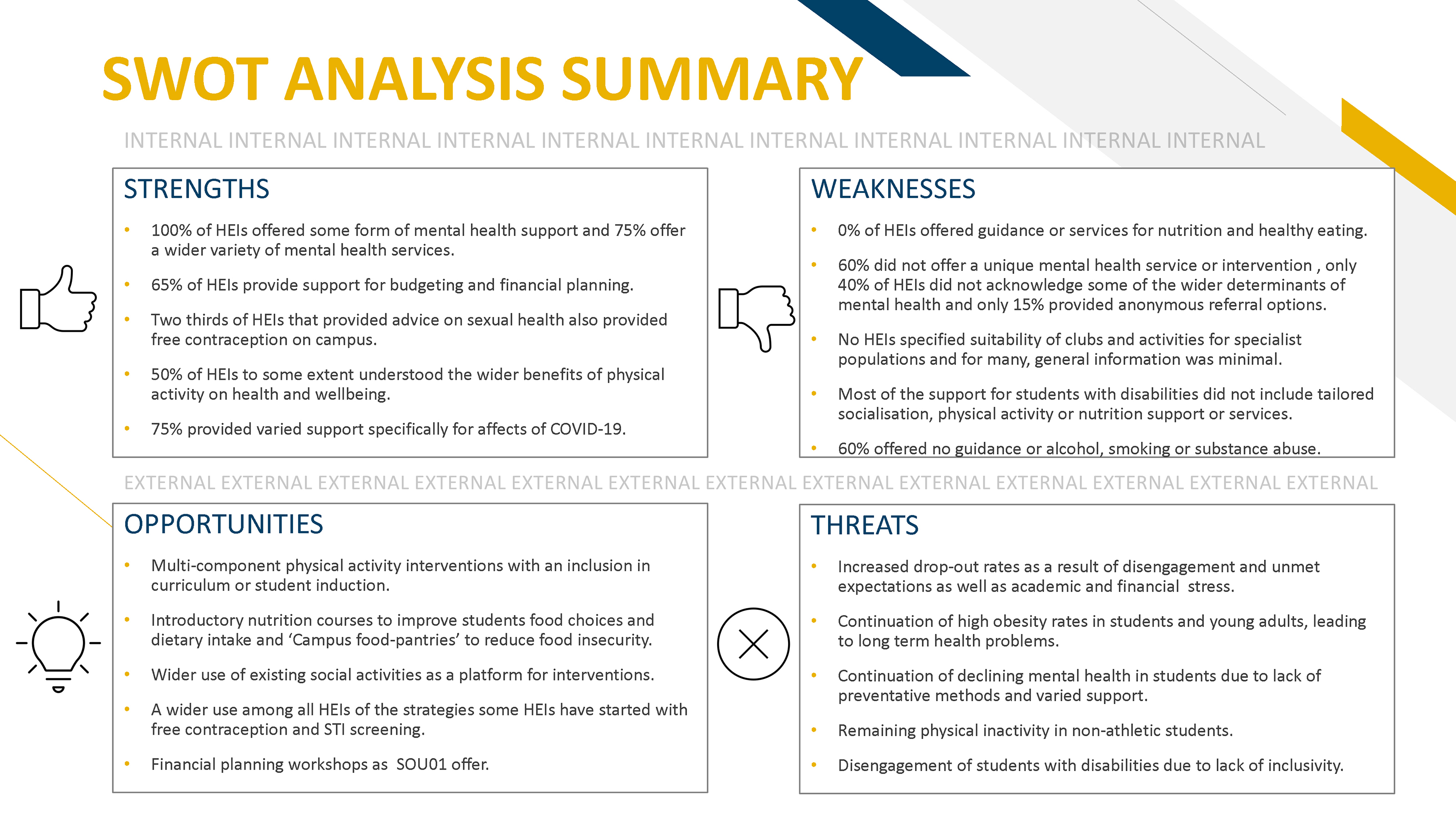
Hannah Farquhar
The Secretary of State for Education of the UK called on universities in 2019 to tackle the high rates of drop-out within higher education institutions (HEIs). Mental Health conditions (MHC) within HEIs tripled between 2012-2018 resulting in lower levels of progression and attainment in students. The epidemiology of MHC within HEIs is rooted to numerous factors such as diet, lifestyle, significant life events (transition between education and employment) and academic pressures. Self-reported anxiety is the highest in high-achieving HEIs.
Method: A review of a random selection of twenty HEIs in England will be obtained in January 2021, assessing their overarching approach to policies and prominent research aiming to monitor and improve student mental wellness.
Aims:To determine to what capacity HEIs in England meet the mental, physical and wellbeing needs of students and how these align with national guidance and their utilisation of initiatives as well as highlighting areas of best practice and innovative approaches.
Conclusion:There’s a need for service expansion within English universities in order to help reduce drop-out rates which may counteract the development of MHC and reduced employability and so reducing mental health finance demands and welfare dependency.

Hannah Farquhar
INTRODUCTION
Numerous studies suggest that poor mental health among students is increasing (Knapstad et al, 2019, Siverston et al, 2019, Tung et al, 2018, Rotenstein et al, 2016). Despite, higher education being associated with better-informed health choices and improved social support (Freudenberg and Ruglis, 2007), ongoing stress as a result of academic pressures has been linked with reduced quality of life (Ribeiro et al, 2017) and susceptibility to other mental health conditions such as anxiety and depression (Moylan et al, 2013).
AIMS OF STUDY
This study aims to critically review current strategies and initiatives employed by UK HEIs around the provision and promotion of positive mental health in students. In addition, the study will scrutinise the ‘Office For Students’ among other structure frameworks and policies and analyse existing research that examines the problems students face in HEIs’ that may also account for the drop-out rates.

University drop-out rates in association with poor mental health are a global issue with findings in Danish (Hjorth et al, 2016) and French students (Saïas et al, 2014) as well as british students all linking declining mental health with a greater risk of dropping out of higher education (Baik et al, 2015). In Finland, a study of 13-17 year old students concluded that poor mental health was linked with adverse academic performance, insufficient reading and writing and poorer social relationships (Fröjd et al, 2008). Depression and anxiety are the most likely developed MHC in students (Thorley, 2017).
STUDENT WELLBEING is declining (Neves and Hilman, 2017) and pre-existing mental health conditions may be exacerbated during the COVID-19 lock-down (Yao et al, 2020) as well as emerging anxiety due to worrying about family (Cao et al, 2020).
POOR MENTAL HEALTH is negatively associated with student’s academic outcome (Sæle et al, 2016, Gnambs and Hanfstingl, 2015), performance and attainment (Patalay et al, 2015, Veldman et al, 2014).

HEIs in England are at risk of encouraging unhealthy behaviours such as drinking, poor diet and sedentary behaviour through the range of social activities, prominent focus on nightlife and community student outlets. More so a significant lack of emphasis placed on healthy eating, food preparation, exercise, money management and academic focus can inadequately prepare students for the transition to adult life and independency. Preventative measures rather than ‘treatments’ for self-reported mental health and support needs are necessary to achieve long-term behaviour change.


ACADEMIC RELATED STRESS (ARS) was said to be the number one cause for student anxiety followed by financial stress (Jones et al, 2018). A German study involving 456 undergraduate medical students displayed lower academic performance as a result of ARS (Kötter et al, 2017). In addition, motivation becomes debilitated (Liu, 2015) and students become disengaged (Benner and Curl, 2018) due to ARS. Walburg (2014) noted that preventing stress and burnout reduced the rate of drop-out as well and improving academic achievement.

FINANCIAL STRESS affects students every year alongside their studies and has been attached to the deteriation in student mental health (Richardson et al, 2015). Financial stress is also linked with an increased likelihood of discontinuation of studies (Britt et al, 2017) and seen as causing students to seek paid work in place of education (Tran et al, 2018, Joo et al, 2008). A 2019 survey of over 3000 students in the UK (Bushi, 2019) found that 79% were worried about having sufficient money to live off and 52% of students were tormented by the thought of loan repayments.
PHYSICAL INACTIVITY (PA) is seen as a cause of declining mental health (Teychenne et al, 2015).
Studies have associated overuse of social media with risk of MHC such as depression and impaired cognitive function (Syväoja et al, 2014) and it was noted that students were spending an average of 2 hours a day on social media at the expense of PA (Calestine et al, 2017).
Students who don’t study a physical education are less likely to engage in PA (Park and Kim, 2013). Raised awareness of PA and varied activities is said to entice students (Deliens et al, 2015).

OBESITY causes students to be ‘at risk of drop-out’ (Lanza and Huang, 2015) and poorer academic achievement (Arora et al, 2013, McCann and Roberts, 2013) as a result of disengagement (Finn et al, 2018). The reduction in parental influence is a paramount cause for the change in food preferences and eating habits in students (Fedewa et al, 2014, Hilger et al, 2017, Barnes et al, 2012) and subsequently university students are more than likely to gain weight during their two years (Brown et al, 2014).
DRINKING and subsequent MHC are a leading public health issue (Bell and Britton, 2014, WHO, 2012) and is a cause of poorer academic performance (Patte et al, 2017) along with SMOKING and DRUG USE (Lee et al, 2013a). Student drinking also causes a greater likelihood of drop-out (Kelly et al, 2015, Latvala et al, 2014).
A poorer Mental Composite Score and increased depressive symptoms were seen in smoking students (Milic et al, 2020) and it is suggested that continuous substance use among students reduced retention (Sillins et al, 2015) and so increases rates of drop-out (Wang and Fredericks, 2014, Arria et al, 2013).

OFFICE FOR STUDENTS Rates of poor mental health among university students has tripled since 2012-2013 to 2017-2018 s (OFS, 2019). Students with a reported mental health condition presented lower rates of progression.
Subjects allied to medicine that may include nutrition, complimentary medicine, therapies and wellbeing, (UCAS, 2014) report the lowest level of poor mental health (OFS, 2021). In the same way that there is a positive response to teaching mental health, perhaps we could consider those studying an allied health subject obtaining a broader understanding of health and wellbeing and so enabling them to become more resilient to poor mental health (McAllister et al, 2017). Higher-achieving HEIs reported higher levels of anxiety compared to specialist, medium and low tariff HEIs (OFS, 2021, Luther et al, 2020).

METHODOLOGY
Out of over 166 “recognised bodies” (Study in the UK, 2021) or universities within the UK, a random selection (Elfil and Negida, 2017) of 20 of those residing in England (140) will be used for a scoping review of HEI websites (as the current ‘prospectus’) (Firth et al, 2019, Young, 2008). The presentation of results will be delivered in the form of SWOT diagram, as it was decided that this template allowed summation of key themes and enabled the study to conclude and present key recommendations for HEI development.





- Arora, T., Hosseini-Araghi, M., Bishop, J., Yao, G., Thomas, G. and Taheri, S., 2013. The complexity of obesity in UK adolescents: relationships with quantity and type of technology, sleep duration and quality, academic performance and aspiration. Pediatric Obesity, 8(5), pp.358-366.
- Arria, A., Garnier-Dykstra, L., Caldeira, K., Vincent, K., Winick, E. and O’Grady, K., 2013. Drug Use Patterns and Continuous Enrollment in College:Results From a Longitudinal Study. Journal of Studies on Alcohol and Drugs, 74(1), pp.71-83.
- Baik C, Naylor R, Arkoudis 2015. The first year experience in Australian universities: Findings from two decades, 1994-2014. Melbourne, Australia: Melbourne Centre for the Study of Higher Education, The University of Melbourne.
- Barnes S.P., Brown K.M., McDermott R.J., Bryant C.A., Kromrey J. 2012. Perceived Parenting Style and the Eating Practices of College Freshmen. Am. J. Health Educ. 2012;43:8–17. doi: 10.1080/19325037.10599213.
- Bell, S. and Britton, A., 2014. An exploration of the dynamic longitudinal relationship between mental health and alcohol consumption: a prospective cohort study. BMC Medicine, 12(1).
- Benner, K. and Curl, A., 2018. Exhausted, Stressed, and Disengaged: Does Employment Create Burnout for Social Work Students?. Journal of Social Work Education, 54(2), pp.300-309.
- Britt, S L.; Ammerman, D A; Barrett, S F.; and Jones, S. 2017. "Student Loans, Financial Stress, and College Student Retention," Journal of Student Financial Aid: Vol. 47 : Iss. 1 , Article 3.
- Brown, O., O’Connor, L. and Savaiano, D., 2014. Mobile MyPlate: A Pilot Study Using Text Messaging to Provide Nutrition Education and Promote Better Dietary Choices in College Students. Journal of American College Health, 62(5), pp.320-327.
- Bushi, R., 2019. Student Money Survey 2019 – Results. [online] Save the Student. Available at: <https://www.savethestudent.org/money/student-money-survey-2019.html> [Accessed 11 January 2021].
- Calestine, J., Bopp, M., Bopp, C. M., & Papalia, Z. (2017). College Student Work Habits are Related to Physical Activity and Fitness. International journal of exercise science, 10(7), 1009–1017.
- Cao, W., Fang, Z., Hou, G., Han, M., Xu, X., Dong, J. and Zheng, J., 2020. The psychological impact of the COVID-19 epidemic on college students in China. Psychiatry Research, 287, p.112934.
- Deliens, T., Deforche, B., De Bourdeaudhuij, I. and Clarys, P., 2015. Determinants of physical activity and sedentary behaviour in university students: a qualitative study using focus group discussions. BMC Public Health, 15(1).
- Elfil, M., & Negida, A. (2017). Sampling methods in Clinical Research; an Educational Review. Emergency (Tehran, Iran), 5(1), e52.
- Fedewa, M., Das, B., Evans, E. and Dishman, R., 2014. Change in Weight and Adiposity in College Students. American Journal of Preventive Medicine, 47(5), pp.641-652.
- Firth, J., Torous, J., Stubbs, B., Firth, J., Steiner, G., Smith, L., Alvarez‐Jimenez, M., Gleeson, J., Vancampfort, D., Armitage, C. and Sarris, J., 2019. The “online brain”: how the Internet may be changing our cognition. World Psychiatry, 18(2), pp.119-129
- Freudenberg, N., & Ruglis, J. 2007. Reframing school dropout as a public health issue. Preventing chronic disease: Public Health Research, Practice, and Policy, 4, 1–11. 16.
- Gnambs, T., & Hanfstingl, B. (2015). The decline of academic motivation during adolescence: An accelerated longitudinal cohort analysis on the effect of psychological need satisfaction. Educational Psychology, 36(9), 1691–1705.
- Hilger, J., Loerbroks, A. and Diehl, K., 2017. Eating behaviour of university students in Germany: Dietary intake, barriers to healthy eating and changes in eating behaviour since the time of matriculation. Appetite, 109, pp.100-107.
- Hjorth, C. F., Bilgrav, L., Frandsen, L. S., Overgaard, C., Torp-Pedersen, C., Nielsen, B., & Bøggild, H. 2016. Mental health and school dropout across educational levels and genders: a 4.8-year follow-up study. BMC public health, 16, 976. https://doi.org/10.1186/s12889-016-3622-8
- Jones, P., Park, S. and Lefevor, G., 2018. Contemporary College Student Anxiety: The Role of Academic Distress, Financial Stress, and Support. Journal of College Counseling, 21(3), pp.252-264.
- Joo, S., Durband, D. and Grable, J., 2008. The Academic Impact of Financial Stress on College Students. Journal of College Student Retention: Research, Theory & Practice, 10(3), pp.287-305.
- Kelly, A., Evans-Whipp, T., Smith, R., Chan, G., Toumbourou, J., Patton, G., Hemphill, S., Hall, W. and Catalano, R., 2015. A longitudinal study of the association of adolescent polydrug use, alcohol use and high school non-completion. Addiction, 110(4), pp.627-635.
- Kötter, T., Wagner, J., Brüheim, L. and Voltmer, E., 2017. Perceived Medical School stress of undergraduate medical students predicts academic performance: an observational study. BMC Medical Education, 17(1).
- Lanza, H. and Huang, D., 2015. Is Obesity Associated With School Dropout? Key Developmental and Ethnic Differences. Journal of School Health, 85(10), pp.663-670.
- Latvala, A., Rose, R., Pulkkinen, L., Dick, D., Korhonen, T. and Kaprio, J., 2014. Drinking, smoking, and educational achievement: Cross-lagged associations from adolescence to adulthood. Drug and Alcohol Dependence, 137, pp.106-113.
- Liu, Y. Y. 2015. The longitudinal relationship between Chinese high school students’ academic stress and academic motivation. Learning and Individual Differences , 38, 123–126.
- Luthar, S., Kumar, N. and Zillmer, N., 2020. Teachers’ responsibilities for students’ mental health:Challenges in high achieving schools. International Journal of School & Educational Psychology, 8(2), pp.119-130.
- Knapstad, M., Sivertsen, B., Knudsen, A., Smith, O., Aarø, L., Lønning, K. and Skogen, J., 2019. Trends in self-reported psychological distress among college and university students from 2010 to 2018. Psychological Medicine, pp.1-9.
- MacCann, C. and Roberts, R., 2013. Just as smart but not as successful: obese students obtain lower school grades but equivalent test scores to nonobese students. International Journal of Obesity, 37(1), pp.40-46
- McAllister, M., Knight, B., Hasking, P., Withyman, C. and Dawkins, J., 2017. Building resilience in regional youth: Impacts of a universal mental health promotion programme. International Journal of Mental Health Nursing, 27(3), pp.1044-1054.
- Milic, M., Gazibara, T., Pekmezovic, T., Kisic Tepavcevic, D., Maric, G., Popovic, A., Stevanovic, J., Patil, K. and Levine, H., 2020. Tobacco smoking and health-related quality of life among university students: Mediating effect of depression. PLOS ONE, 15(1), p.e0227042.
- Moylan, S. , Maes, M. , Wray, N. R. , & Berk, M. 2013. The neuroprogressive nature of major depressive disorder: Pathways to disease evolution and resistance, and therapeutic implications. Molecular Psychiatry , 18 5, 595–606.
- Neves and Hillman. 2017. Student Academic Experience Survey 2017, Higher Education Academy and Higher Education Policy Institute. http://www.hepi.ac.uk/wp-content/ uploads/2017/06/2017-Student-Academic-Experience-Survey-Final-Report.pdf
- Officeforstudents.org.uk. 2021. Anxiety - Office For Students. [online] Available at: <https://www.officeforstudents.org.uk/data-and-analysis/personal-wellbeing-of-graduates/anxiety/> [Accessed 3 January 2021].
- Officeforstudents.org.uk. 2019. Access And Participation Data Analysis - Students With Reported Mental Health Conditions. [online] Available at: <https://www.officeforstudents.org.uk/media/d5a5c2b5-d961-49e3-89ef-94ed4847b01a/access-and-participation-data-analysis.pdf> [Accessed 3 January 2021].
- Park, J. and Kim, N., 2013. Relationships between Physical Activity, Health Status, and Quality of Life of University Students. Journal of Korean Public Health Nursing, 27(1), pp.153-165.
- Patalay, P., Deighton, J., Fonagy, P., & Wolpert, M. (2015). The relationship between internalizing symptom development and academic attainment in early adolescence. PLoS One, 10(1), E0116821.10.1371/journal.pone.0116821
- Patte, K., Qian, W. and Leatherdale, S., 2017. Binge drinking and academic performance, engagement, aspirations, and expectations: a longitudinal analysis among secondary school students in the COMPASS study. Health Promotion and Chronic Disease Prevention in Canada, 37(11), pp.376-385.
- Richardson, T., Elliott, P. and Roberts, R., 2015. The impact of tuition fees amount on mental health over time in British students. Journal of Public Health, 37(3), pp.412-418.
- Ribeiro, Í. J. S. , Pereira, R. , Freire, I. V. , de Oliveira, B. G. , Casotti, C. A. , & Boery, E. N. 2017. Stress and quality of life among university students: A systematic literature review. Health Professions Education .
- Rotenstein, L., Ramos, M., Torre, M., Segal, J., Peluso, M., Guille, C., Sen, S. and Mata, D., 2016. Prevalence of Depression, Depressive Symptoms, and Suicidal Ideation Among Medical Students. JAMA, 316(21), p.2214.
- Sæle, R. G., Sørlie, T., Nergård-Nilssen, T., Ottosen, K. O., Goll, C. B., & Friborg, O. (2016). Demographic and psychological predictors of grade point average (GPA) in North-Norway: A particular analysis of cognitive/school-related and literacy problems. Educational Psychology, 36, 1886–1907.10.1080/01443410.2014.998630
- Saïas, T., du Roscoät, E., Véron, L., Guignard, R., Richard, J., Legleye, S., Sauvade, F., Kovess, V. and Beck, F., 2014. Psychological distress in French college students: demographic, economic and social stressors. Results from the 2010 National Health Barometer. BMC Public Health, 14(1).
- Sivertsen, B., Hysing, M., Knapstad, M., Harvey, A., Reneflot, A., Lønning, K. and O'Connor, R., 2019. Suicide attempts and non-suicidal self-harm among university students: prevalence study. BJPsych Open, 5(2).
- Study in UK, 2021. List Of Universities In The United Kingdom - Study In UK. [online] Study in UK. Available at: <https://www.studying-in-uk.org/list-of-universities-in-the-united-kingdom/> [Accessed 7 January 2021].
- Syväoja, H., Tammelin, T., Ahonen, T., Kankaanpää, A. and Kantomaa, M., 2014. The Associations of Objectively Measured Physical Activity and Sedentary Time with Cognitive Functions in School-Aged Children. PLoS ONE, 9(7), p.e103559.
- Teychenne, M., Costigan, S. and Parker, K., 2015. The association between sedentary behaviour and risk of anxiety: a systematic review. BMC Public Health, 15(1).
- Thorley C. 2017. Not By Degrees: Improving student mental health in the UK's Universities, IPPR. http://www.ippr.org/research/publications/not-by-degrees
- Tran, A., Lam, C. and Legg, E., 2018. Financial Stress, Social Supports, Gender, and Anxiety During College: A Stress-Buffering Perspective. The Counseling Psychologist, 46(7), pp.846-869.
- Tung, Y., Lo, K., Ho, R. and Tam, W., 2018. Prevalence of depression among nursing students: A systematic review and meta-analysis. Nurse Education Today, 63, pp.119-129.
- Ucas.com. 2014. UCAS Postgraduate - Medicine And Allied Subjects Statistics 2013-2014. [online] Available at: <https://www.ucas.com/sites/default/files/md-1355_medicine_and_allied_subjects_v3.pdf> [Accessed 3 January 2021].
- Veldman, K., Bültmann, U., Stewart, R. E., Ormel, J., Verhulst, & Reijneveld, S. A. (2014). Mental health problems and educational attainment in adolescence: 9-year follow-up on the TRAILS study. PLoS One, 9(7), e101751.10.1371/journal.pone.0101751
- Walburg, V. 2014. Burnout among high school students: A literature review. Children and Youth Services Review , 42, 28–33.
- Wang, M. and Fredricks, J., 2014. The Reciprocal Links Between School Engagement, Youth Problem Behaviors, and School Dropout During Adolescence. Child Development, 85(2), pp.722-737.
- WHO 2012. Alcohol in the European Union Consumption, Harm and Policy Approaches Copenhagen,: World Health Organisation Regional Office for Europe.
- Yao, H., Chen, J. and Xu, Y., 2020. Patients with mental health disorders in the COVID-19 epidemic. The Lancet Psychiatry, 7(4), p.e21.
- Young, A., 2008. Aftermath of a Prediction: F. W. Lancaster and the Paperless Society. Library Trends, 56(4), pp.843-858.



Out of the 20 HEI reviewed, none provided on-campus guidance and support for all of the contributing factors to student wellbeing and happiness as outlined in the literature review. Among all the HEI’s in the study, the area of greatest service variation was mental health support and determinant of student wellbeing most underrepresented was Nutrition. The most common threat identified was the risk of student addiction to alcohol, smoking and substance use due to lack of preventative measures and services for support. The frequently identified opportunity for all universities was the introduction of more preventative measures rather than ‘treatments’ for self-reported mental health and support needs.




































































































































































































































































































































































































































































































































































































































































































































































































































































































































































































































































































































































































































































































